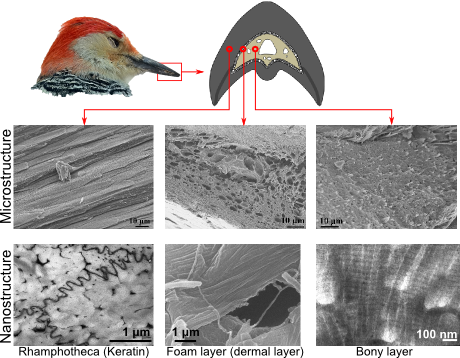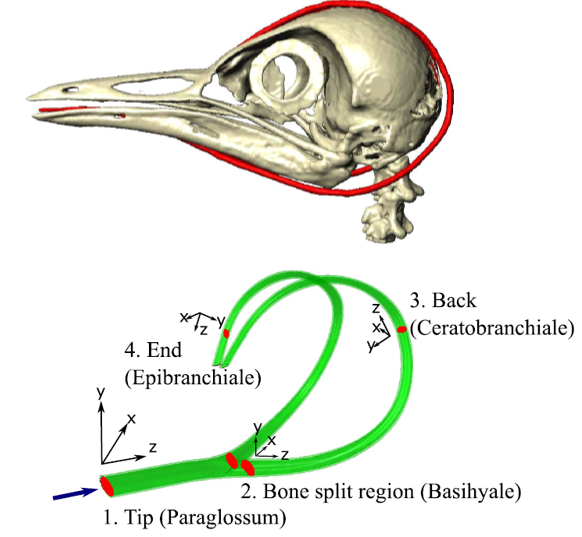Woodpeckers
Woodpeckers show amazingly efficient shock absorption capabilities without any recorded damage to their beaks or brains while pecking trees. By analyzing the woodpecker, CAVS researchers gained a deeper understanding of the energy absorption capabilities of biological structural materials’ mechanisms.
When a woodpecker makes a blow into the tree trunk, its beak repeatedly strikes at a speed of 6–7 m, and the impact deceleration is of the order of 1000 g. Comprised of three structural layers - an outer rhamphotheca layer (keratin sheath), a middle foam layer and an inner bony layer, each layer of the beak functions to dissipate impact, while maintaining its structural integrity. A wavy gap evidenced in the rhamphotheca demonstrates its function of damping stress wave using FEM. The middle foam layer joins two dissimilar materials of exterior protein and interior bone using functional gradient material and changing porosity.

The nano- and micro-indentation tests revealed that the hardness - which is associated with the strength, modulus and stiffness of the rhamphotheca layer (approx. 470 MPa for nano and approx. 320 MPa for micro) - was two to three times less than that of the bony layer (approx. 1200 MPa for nano and approx. 630 MPa for micro).
- More elongated keratin scales can slide over each other, admitting dissipation via shearing
- With much less porosity in the bony layer, the beak is strengthened and the stress wave is focused
- Has a wavy suture that admits local shearing at the nanoscale

CAVS researchers also evaluated the function of the woodpecker’s hyoid apparatus in regard to energy dissipation. The hyoid bone, comprised of bone and muscle, has a unique geometry compared to those of other birds. The whole length of the hyoid, which starts at the beak tip, surrounds the woodpecker’s skull and ends at the upper beak/front head intersection, is surrounded by muscle.
Simulation results show that as the stress wave traveled from the anterior to the posterior end of the hyoid apparatus, its pressure decreased 75% and the associated impulse decreased 84%, due to its tapered spiral geometry. This analysis of the woodpecker provides some understanding of biological structural materials’ mechanisms for energy absorption.
References
- Lee, Nayeon, et al. “Hierarchical multiscale structure–property relationships of the red-bellied woodpecker (Melanerpes carolinus) beak.” Journal of The Royal Society Interface 11, no. 96 (2014): 20140274.
- Lee, Nayeon, et al. “Stress wave mitigation at suture interfaces.” Biomedical Physics & Engineering Express 3, no. 3 (2017): 035025.
- Lee, Nayeon, et al. “The geometric effects of a woodpecker’s hyoid apparatus for stress wave mitigation.” Bioinspiration & biomimetics 11, no. 6 (2016): 066004.
